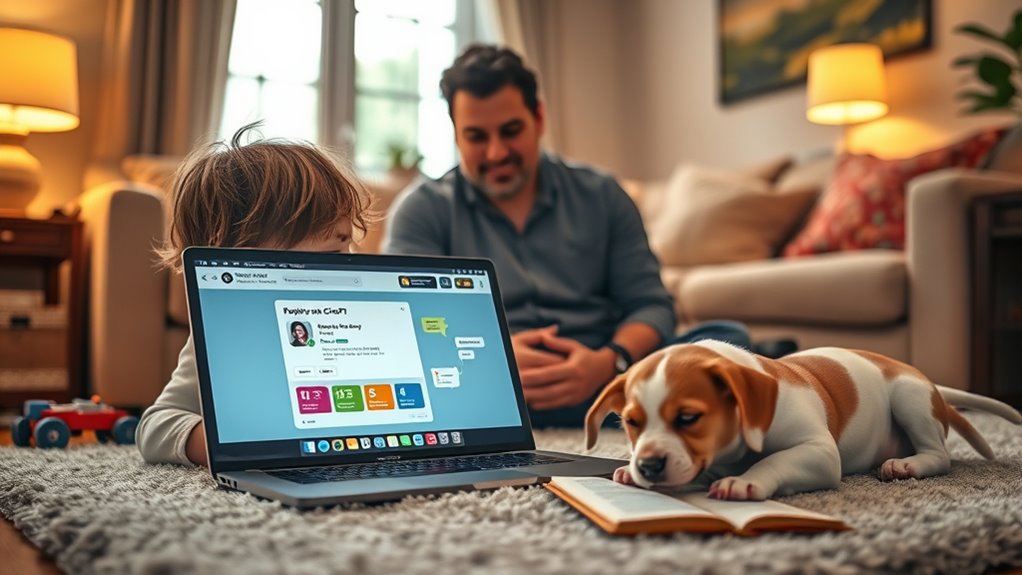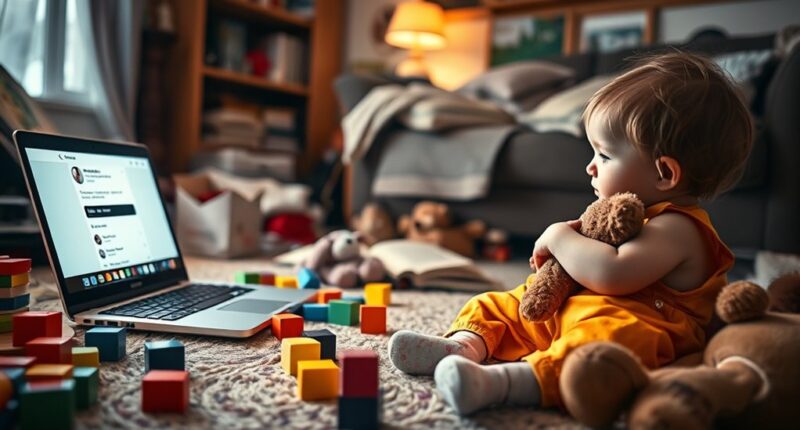ChatGPT became the accidental babysitter because it’s easily accessible, quick to interact with, and offers endless entertainment for kids. Since its launch in 2022, many children under 13 use it for storytelling, jokes, and questions, often without strict age checks. It simulates social interaction, making kids feel like they’re chatting with a playmate. If you want to discover how it influences child safety and what steps parents are taking, keep exploring further.
Key Takeaways
- Launched in 2022, ChatGPT quickly gained popularity as a versatile digital companion for children.
- Its ease of access and minimal age verification led kids under 13 to use it as a playmate and learning tool.
- Children rely on ChatGPT for storytelling, jokes, and answers, often treating it as a social interaction substitute.
- Parents and experts highlight risks like social skill development issues and exposure to misinformation.
- Lack of strict regulation and oversight contributed to its role as an accidental babysitter for millions.

Since its launch in 2022, ChatGPT has become a common fixture in many homes, often serving as an accidental babysitter. You might notice parents and caregivers turning to it to keep children entertained during busy moments or while working from home. Many kids under 13 access ChatGPT despite age restrictions, thanks to minimal verification processes, making it surprisingly easy for younger children to use. Its quick rise in popularity means that, in just a short time, ChatGPT has become a go-to tool for engaging children in various ways, including storytelling, answering questions, and providing simple entertainment. Its widespread use has prompted discussions about safety and the importance of monitoring children’s interactions with AI. Parents often rely on ChatGPT as a digital companion to occupy kids temporarily, giving adults a break to handle other responsibilities. Anecdotal and survey data show that many use it as an informal babysitter, trusting its interactive storytelling and conversational abilities to distract or soothe children. You’ll see children engaging with ChatGPT through conversations that generate stories, jokes, riddles, and educational content tailored to their interests and age. Its capacity to simulate basic social interaction makes it feel like a playmate, even though it’s just a text-based AI. Kids tend to treat ChatGPT as a source of answers to their endless curiosity, benefiting from its extensive knowledge base and ability to adapt responses when questions are repeated. However, since the AI operates solely through dialogue, it lacks physical interaction, limiting its role to a digital conversation partner. The convenience of AI babysitters has led to concerns about overreliance on technology for child supervision. The benefits of using ChatGPT as an informal babysitter are clear. It allows parents to focus on other tasks without constant supervision for short periods. It also supports early education by encouraging curiosity and providing interactive learning opportunities. Through storytelling and problem-solving activities, children can develop creativity and cognitive skills. Additionally, ChatGPT fosters literacy by prompting children to read and comprehend text, offering a distraction that’s safer than unrestricted internet browsing. Healthy dog snacks can also be a fun way to reward children while they engage with the AI. Still, experts warn of significant risks. They emphasize that AI can’t replace essential human interactions like cuddling, playing, or face-to-face engagement, which are indispensable for emotional and social development. Overdependence on AI babysitting might hinder children’s social skills and emotional regulation. The lack of strict regulation and monitoring raises privacy concerns and exposes children to potential misinformation or inappropriate content, as ChatGPT doesn’t truly understand what it says. Its conversational nature can also create emotional confusion, as children may mistake its responses for genuine feelings or empathy. While some parental controls and age restrictions are in place, enforcement is inconsistent. Experts recommend active supervision during AI use to ensure children stay safe and receive appropriate interaction. Ultimately, ChatGPT’s role as an accidental babysitter highlights both its usefulness and the need for cautious oversight to protect children’s well-being while benefiting from its educational and entertainment potential.
Frequently Asked Questions
How Does Chatgpt Handle Children’s Privacy Concerns?
You’re right to be concerned about children’s privacy with ChatGPT. It’s designed to block users under 13 and requires parental consent for ages 13-18. OpenAI doesn’t intentionally collect personal data from kids, but it’s important to supervise children’s use and utilize third-party tools for added safety. You can also opt out of data sharing and request data removal, giving you more control over your child’s privacy.
Are There Safety Features to Prevent Inappropriate Responses to Kids?
Aren’t safety features enough to prevent all inappropriate responses? ChatGPT has built-in protections to block sensitive topics and flag concerning behavior, alerting parents or reviewers if needed. You can customize these controls, like limiting voice or image features, and disable data sharing for extra privacy. While these measures improve safety, no system is perfect. It’s crucial you stay involved, monitor your child’s use, and set clear boundaries to ensure they’re truly protected.
Can Chatgpt Help With Educational Activities for Children?
Yes, ChatGPT can help with educational activities for children by providing engaging, age-appropriate content that supports learning across subjects. You can use it to generate fun quizzes, explain concepts in simple language, and encourage critical thinking through interactive questions. Just make certain you guide your children’s usage, monitor their interactions, and reinforce skills like evaluating AI responses to foster responsible and effective learning experiences.
What Are the Limitations of Chatgpt as a Babysitter?
You should know that ChatGPT has several limitations as a babysitter. It’s not designed for children under 13, and even teens should use it cautiously. The AI can miss inappropriate content, generate false information, and lacks emotional understanding. Plus, there are privacy risks, since conversations aren’t fully protected, and no parental controls are available. It can’t replace human supervision, and prolonged use may lead to social isolation or reliance on AI over real interactions.
Does Chatgpt Require Parental Supervision During Interactions?
ChatGPT doesn’t require constant parental supervision, but it’s strongly recommended. Think of it as a powerful tool that can be misused if left unchecked—like a wild stallion. Parental controls and ongoing conversations help guarantee your teen’s safety, monitor their interactions, and set boundaries. While the AI offers helpful guidance, active parental involvement remains vital to prevent exposure to inappropriate content and to foster responsible use.
Conclusion
While it might feel strange to see ChatGPT as an unintended babysitter, remember it’s designed to help and entertain, not replace real caregiving. You might worry about relying too much on technology, but when used responsibly, it can be a valuable tool for learning and connection. Embrace its role as a helpful companion, and you’ll discover how AI can support your family without taking over the important human touch.









